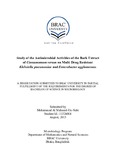| dc.contributor.advisor | Mannoor, Dr. Md. Kaiissar | |
| dc.contributor.advisor | Hossain, Dr. Mahboob | |
| dc.contributor.author | Mahmud-Un-Nabi, Mohammad Al | |
| dc.date.accessioned | 2015-09-23T06:30:13Z | |
| dc.date.available | 2015-09-23T06:30:13Z | |
| dc.date.copyright | 2015 | |
| dc.date.issued | 2015-08 | |
| dc.identifier.other | ID 11326004 | |
| dc.identifier.uri | http://hdl.handle.net/10361/4440 | |
| dc.description | This thesis is submitted in partial fulfillment of the requirements for the degree of Bachelor of Science in Microbiology, 2015 | en_US |
| dc.description | Cataloged from PDF version of thesis report. | |
| dc.description | Includes bibliographical references (page 39-40). | |
| dc.description.abstract | Infections caused by Multi Drug Resistant (MDR) organisms cause to stand a
worldwide pandemic. MDR bacteria are an emerging threat with limited therapeutic
options. Without having information about these strains, morbidity and mortality due to
infections caused by these notorious bugs cannot be reduced. Alternative antimicrobial
agent is needed beside the antibiotics to combat against these MDR organisms. Cinnamon
is a spice obtained from the inner bark of trees of Cinnamomum sp. Traditionally it has
also been used for medicinal purposes. In the current work we evaluated the antimicrobial
activity of the cinnamon extract against MDR Klebsiella pneumoniae and Enterobacter
aggalomerans, and also compared the results with drug sensitive organisms of the same
species. Cinnamon extract was prepared with ethanol extraction procedure. The extract
was dried and re-dissolved in Dimethyl sulfoxide (DMSO). The prepared extract was
tested on the organisms by using agar diffusion technique followed by determination of
Minimum Inhibitory Concentration (MIC) and Minimum Bactericidal Concentration
(MBC) of the cinnamon extract. From the agar diffusion test the minimum concentration
of cinnamon extracts needed to visualise the zone of inhibition on the Mueller Hinton
Agar was determined to be 40 mg/ml. The MIC of the cinnamon extract was found to be 1
mg/ml and the MBC was determined as 2 mg/ml. The results obtained from this study can
act as the stepping stone in investigating the antimicrobial properties of cinnamon extract.
This study could be the beginning of discovering a new antimicrobial agent against the
MDR organisms. | en_US |
| dc.description.statementofresponsibility | Mohammad Al Mahmud-Un-Nabi | |
| dc.format.extent | 40 pages | |
| dc.language.iso | en | en_US |
| dc.publisher | BRAC University | en_US |
| dc.rights | BRAC University thesis are protected by copyright. They may be viewed from this source for any purpose, but reproduction or distribution in any format is prohibited without written permission. | |
| dc.subject | Microbiology | en_US |
| dc.subject | Antimicrobial | en_US |
| dc.subject | Klebsiella pneumoniae | en_US |
| dc.subject | Enterobacter agglomerans | en_US |
| dc.subject | Cinnamomum verum | en_US |
| dc.title | Study of the antimicrobial activities of the bark extract of cinnamomum verum on multi drug resistant klebsiella pneumoniae and enterobacter agglomerans | en_US |
| dc.type | Thesis | en_US |
| dc.contributor.department | Department of Mathematical and Natural Science, BRAC University | |
| dc.description.degree | B. Microbiology | |

